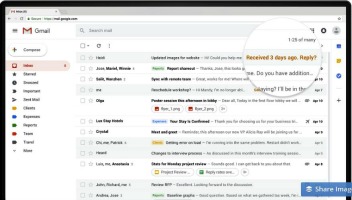Mary Meeker’s 2015 Internet Trends Report is out.
Meeker, a partner at Kleiner Perkins (yes, that Kleiner Perkins), annually drops a large deck of trends and statistics for us to ponder. This year’s report is arranged into six main sections covering population and business stats, key Internet trends, “reimaging,” evolving work, China and India (aka, two big Internet markets), and public / private company data. Meeker adds “ran outta time thoughts” at the end.
The data on platforms and digital usage tend to get the most attention from the tech blogs and business press. They are the low-hanging fruit.
Here’s what I think is really noteworthy.
1. Education and healthcare are ripe for disruption.
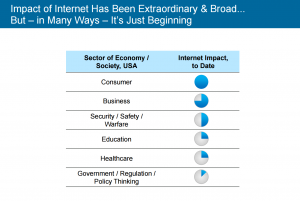
This slide is a fascinating illustration of how little the Internet has to date impacted some key sectors. While companies (broadly) have reacted, some sectors have lagged behind. In education, for example, we’re just seeing the early impact of MOOCs and how they’re forcing major universities to rethink their models. We’re experimenting with new ways to teach young kids. In health care, telemedicine is gaining traction. Meeker includes slides late in her presentation about changing payment models and the potential impact of technology on costs.
2. Mobile advertising is the future.
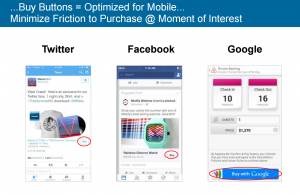
Meeker has several slides that show the growth of mobile advertising. It’s clearly an area of opportunity within the ad realm. The addition of “buy” buttons takes this from the banner ad category to a tool that can seamlessly move a user from browser to buyer.
3. Video goes vertical.
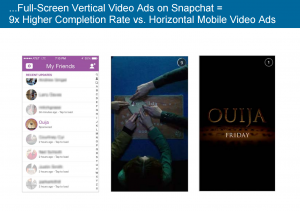
I must admit, this caught me by surprise. And I’m not sure the advertising viewing data can be carried over into viewing videos we’re opting to watch. That said, the data is noteworthy: vertical video ads on Snapchat have a completion rate nine times higher than for horizontal mobile ads. Meeker suggests that because we’re viewing more and more video on smaller (smartphone and tablet) screens, video needs to be formatted for vertical screens.
4. Software is solving business pain points.
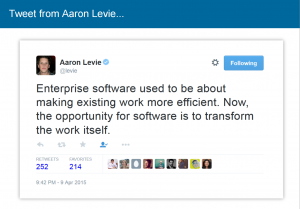
Meeker’s presentation has a series of slides around how software developers have tackled business processes, including payments, analytics, document signing, employee training, customer service, recruiting, and more. For example, my new Microsoft computer comes with a bluetooth-enabled pen that lets me sign documents right on the screen–saving me time on printing out and scanning back in.
5. Mobile messaging is on the rise.
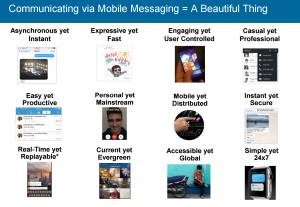
According to Meeker, six of the top 10 most-used apps globally are messaging apps. We’re talking more and more via text. One of the statistics I cited in 10 Trends to See, Watch, and Act on in 2015 is that text messages are read within four minutes of receipt. SMS cuts through the clutter.
6. People want workplace flexibility.
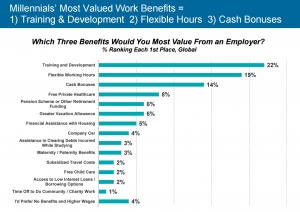
Meeker has an series of slides about the evolving work environment. What’s interesting to me is how technology has shifted what’s possible (enabling us, for example, to be digital nomads). Meeker’s slides focus on how millennials are different. Yes, they are–they’re the first generation to enter a workforce where the tech tools were in place to work more flexibility. That doesn’t mean that other generations didn’t want these same benefits; they just didn’t have the enabling environment to demand them.
7. Good design is not an afterthought.
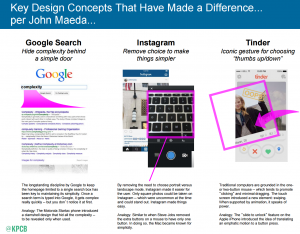
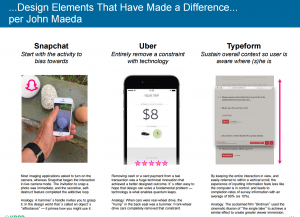
Good design is really important. Google’s material design initiative is another example.
Meeker tosses in her thoughts about design at the back of the presentation. It’s a little unfortunate, because I don’t think they get as much attention as they should.
Bonus takeaway: Watch for regulation.
Meeker has a series of slides on the tension between tech innovation and regulation. Think Uber and taxicab commissions. Airbnb and local hotel regulations. Amazon and state taxes. The area of this that interests me most (and has for a while) is what our increasingly “hands-off” workforce means with respect to the legal definitions of employer and employee. It’s unsettled–and, at times, unsettling too.
Here’s the full 196-page 2015 Internet Trends Report (click here if you can’t see it) if you want to deep dive into it for yourself.
Feature photo by Thomas Leuthard (Flickr).



